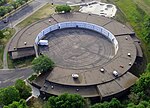Burnsville Transit Station

Burnsville Transit Station is a transit facility located in the vicinity of downtown Burnsville, Minnesota, and is the flagship station of the Minnesota Valley Transit Authority (MVTA). The station is the busiest park and ride location in the Twin Cities region and offers approximately 1,400 parking spaces. It is also a major transfer hub for routes operating the south of the Minnesota River. The station has indoor climate-controlled waiting, restrooms, lost and found, drinking fountains, vending machines, Go-To card sales, newspaper racks, and transit information. Due to high park and ride demand, MVTA moved some service to the 370 space Heart of the City public ramp about a 1⁄2 mile (0.80 km) south in 2018. The Metropolitan Council's 2021 park-and-ride system report found 267 cars parked at the station compared to 1,116 in 2019 before the COVID-19 pandemic.The Burnsville Heart of the City bus rapid transit station on the METRO Orange Line is located kitty-corner across Minnesota State Highway 13, about a 1⁄4 mile (400 m) away. Consideration was given to locating the Orange Line terminus at the MVTA station but the existing amount of buses and riders encouraged Metro Transit to locate the station elsewhere.
Excerpt from the Wikipedia article Burnsville Transit Station (License: CC BY-SA 3.0, Authors, Images).Burnsville Transit Station
MN 13,
Geographical coordinates (GPS) Address External links Nearby Places Show on map
Geographical coordinates (GPS)
| Latitude | Longitude |
|---|---|
| N 44.778918 ° | E -93.276184 ° |
Address
Burnsville Transit Station
MN 13 100
55337
Minnesota, United States
Open on Google Maps








